美国、日本和中国的教育比较的英文(中西文化对比)
- 格式:ppt
- 大小:3.96 MB
- 文档页数:34
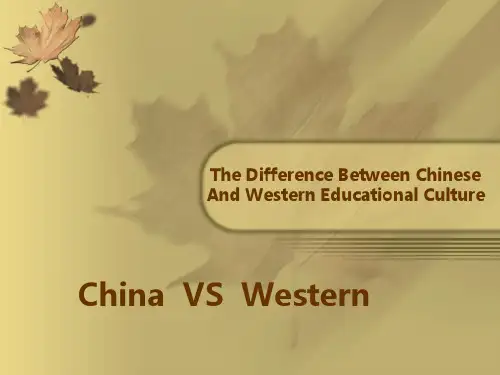

对比中西方教育文化的不同英语作文Education is an essential aspect of society, shaping individuals' values, beliefs, and behaviors. Both Western and Eastern cultures have distinct educational systems that reflect their unique values and traditions. In this essay, we will compare and contrast the educational cultures of the West and the East.One of the key differences between Western and Eastern education is the focus on individuality versus collectivism. In Western cultures, individual autonomy and independence are highly valued, and students are encouraged to think critically and express their opinions freely. In contrast, Eastern cultures prioritize group harmony and conformity, with an emphasis on obedience and respect for authority.Moreover, the teaching methods employed in Western and Eastern education systems are also distinct. Western education tends to be more student-centered, with an emphasis on interactive and participatory learning. Students are encouraged to engage in debates, discussions, and hands-on activities to foster critical thinking and creativity. In contrast, Eastern education is often teacher-centered, with a greater emphasis on rote learning, memorization, and repetition.Another key difference between Western and Eastern education is the curriculum content. Western education places a strong emphasis on a broad and liberal arts education, with a focus on developing well-rounded individuals with diverse interests and skills. In contrast, Eastern education tends to prioritize technical skills and vocational training, with an emphasis on academic achievement and success in standardized tests.Furthermore, the role of parents and teachers in Western and Eastern education is also different. In Western cultures, parents are often seen as partners in their children's education, with a focus on nurturing their child's individual talents and interests. Teachers are viewed as facilitators and guides, encouraging students to explore and discover knowledge on their own. In contrast, Eastern cultures place a strong emphasis on parental involvement in education, with parents taking a more active role in directing their child's academic pursuits. Teachers are revered and respected figures, with students expected to show deference and obedience.In conclusion, while both Western and Eastern education systems aim to prepare students for success in the modern world, they do so in distinct ways that reflect their unique culturalvalues and traditions. Western education emphasizes individuality, critical thinking, and creativity, while Eastern education prioritizes collectivism, obedience, and academic achievement. By understanding and appreciating the differences between these two educational cultures, we can gain a deeper insight into the diverse ways in which societies educate and shape their future generations.。
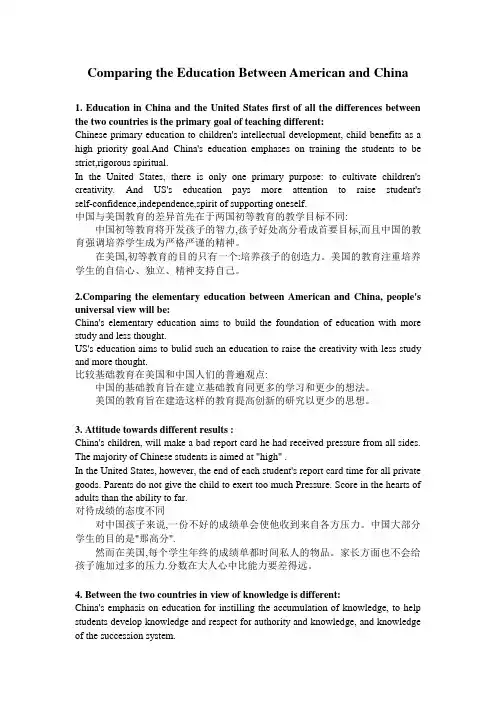
Comparing the Education Between American and China1. Education in China and the United States first of all the differences between the two countries is the primary goal of teaching different:Chinese primary education to children's intellectual development, child benefits as a high priority goal.And China's education emphases on training the students to be strict,rigorous spiritual.In the United States, there is only one primary purpose: to cultivate children's creativity. And US's education pays more attention to raise student's self-confidence,independence,spirit of supporting oneself.中国与美国教育的差异首先在于两国初等教育的教学目标不同:中国初等教育将开发孩子的智力,孩子好处高分看成首要目标,而且中国的教育强调培养学生成为严格严谨的精神。
在美国,初等教育的目的只有一个:培养孩子的创造力。
美国的教育注重培养学生的自信心、独立、精神支持自己。
paring the elementary education between American and China, people's universal view will be:China's elementary education aims to build the foundation of education with more study and less thought.US's education aims to bulid such an education to raise the creativity with less study and more thought.比较基础教育在美国和中国人们的普遍观点:中国的基础教育旨在建立基础教育同更多的学习和更少的想法。
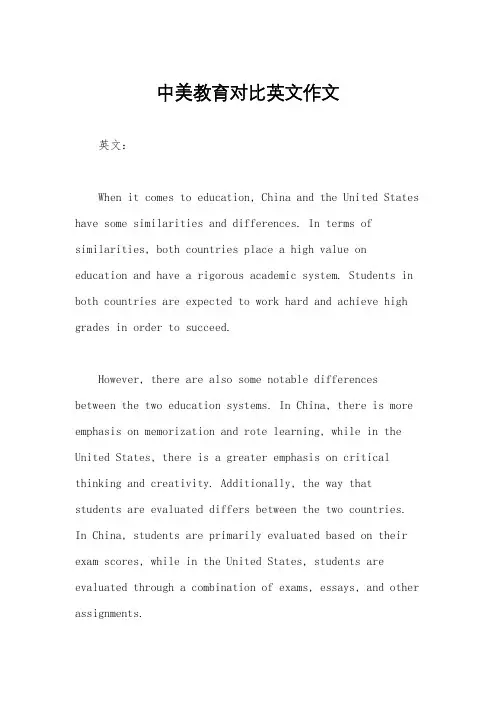
中美教育对比英文作文英文:When it comes to education, China and the United States have some similarities and differences. In terms of similarities, both countries place a high value on education and have a rigorous academic system. Students in both countries are expected to work hard and achieve high grades in order to succeed.However, there are also some notable differences between the two education systems. In China, there is more emphasis on memorization and rote learning, while in the United States, there is a greater emphasis on critical thinking and creativity. Additionally, the way that students are evaluated differs between the two countries. In China, students are primarily evaluated based on their exam scores, while in the United States, students are evaluated through a combination of exams, essays, and other assignments.Another difference between the two education systems is the role of extracurricular activities. In the United States, extracurricular activities such as sports, music, and clubs are seen as an important part of a student's education and can even help with college admissions. In China, however, there is less emphasis on extracurricular activities and more emphasis on academic achievement.Overall, both China and the United States have their strengths and weaknesses when it comes to education. While China may excel in areas such as rote learning and exam preparation, the United States may excel in fostering creativity and critical thinking skills.中文:说到教育,中美两国有一些相似之处和不同之处。
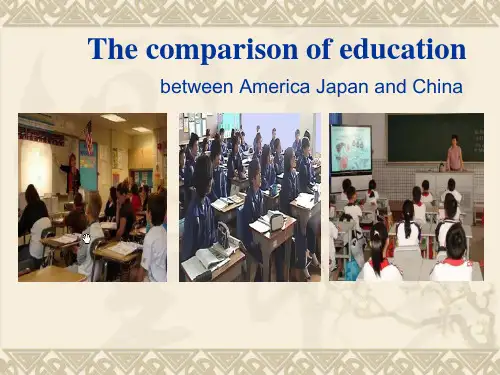
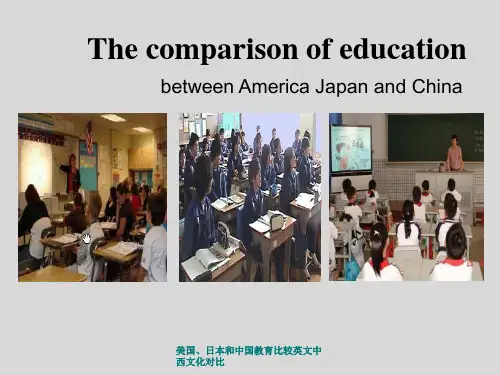
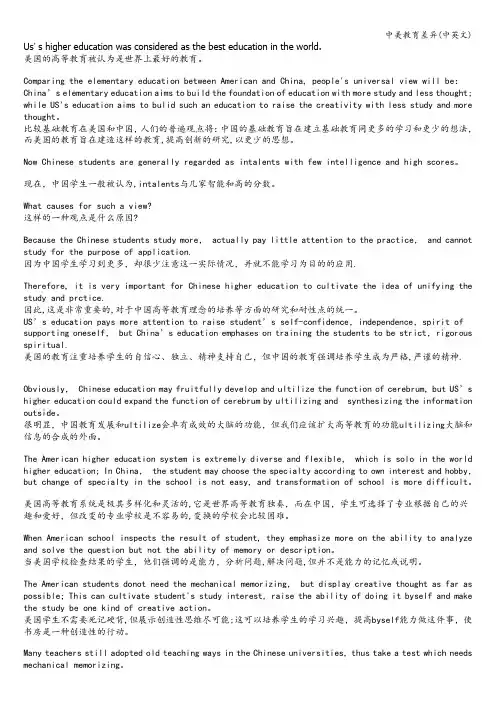
Us's higher education was considered as the best education in the world.美国的高等教育被认为是世界上最好的教育。
Comparing the elementary education between American and China, people's universal view will be:China’s elementary education aims to build the foundation of ed ucation with more study and less thought; while US's education aims to bulid such an education to raise the creativity with less study and more thought。
比较基础教育在美国和中国,人们的普遍观点将:中国的基础教育旨在建立基础教育同更多的学习和更少的想法,而美国的教育旨在建造这样的教育,提高创新的研究,以更少的思想。
Now Chinese students are generally regarded as intalents with few intelligence and high scores。
现在,中国学生一般被认为,intalents与几家智能和高的分数。
What causes for such a view?这样的一种观点是什么原因?Because the Chinese students study more, actually pay little attention to the practice, and cannot study for the purpose of application.因为中国学生学习到更多,却很少注意这一实际情况,并就不能学习为目的的应用.Therefore, it is very important for Chinese higher education to cultivate the idea of unifying the study and prctice.因此,这是非常重要的,对于中国高等教育理念的培养等方面的研究和耐性点的统一。

篇一:中美教育差异对比education is culture, and different educations show different societies’ culture. americans regard education as the means by which the inequalities among individuals are to be erased and by which every desirable end is to be achieved. while chinese education is for foundation education, but students may be not learn much. but all in all, different education systems account for the different phenomenon, because different society backgrounds and different culture helps human create a different country in the world.the different society structure plays an important part in the education system. in china, all those who can enter the university have received an elite education and before enrollment they have devoted themselves to hard studying. therefore, they are good at getting high marks on mathematics, psychics and so on. however, they are lack of chances to practice skills in real world thus having no social experiences. in that case, after graduation, most students find it difficult to find a satisfactory job though many of them get a job through the relationship net.while in america, the education system pays more attention to social skills than to marks .students have developed the ability to be independence in life and work. after university, they show great capability of thinking, innovation and creation which make them keep pace with the modern world. they are competent for the challenging work and can gain a good job in america with ease.there is a huge gap on education between america and china, but we can’t say which one is right or wrong, ‘cause each of the education system is based on the different backgrounds,american education should be following the american’s cu lture, meanwhile, chinese education has to follow chinese culture. a good education model for china is very important to the learning process, and also is very hard. but the most important thing we need is the modern education which is internationalization education system and localization education systems unite for china and america, this is also what the education itself needs. 篇二:中美教育差异the differences of education between china and u.sbased on checking the extensive literature and summing up the evidence, it is clear that study about differences of higher education between china and us has carried out a lot which mainly explaines the differences from different aspects of higher edcation between china and the united states. such aspects mainly includes the social environment and cultural tradition, higher education system and reform measures. in the integration of these differences, advantages and evils of both educational systems have been evaluated respectively, and corresponding improvement measures were also put forwords. by summary, the detailed conclusions are listed as follows:。
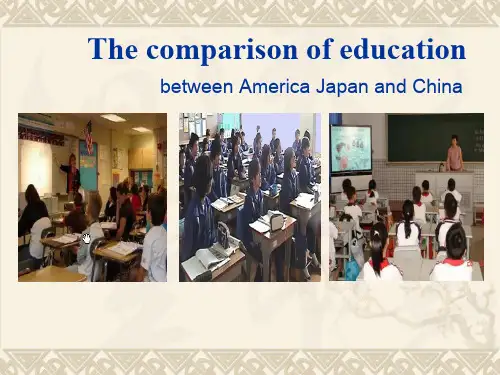
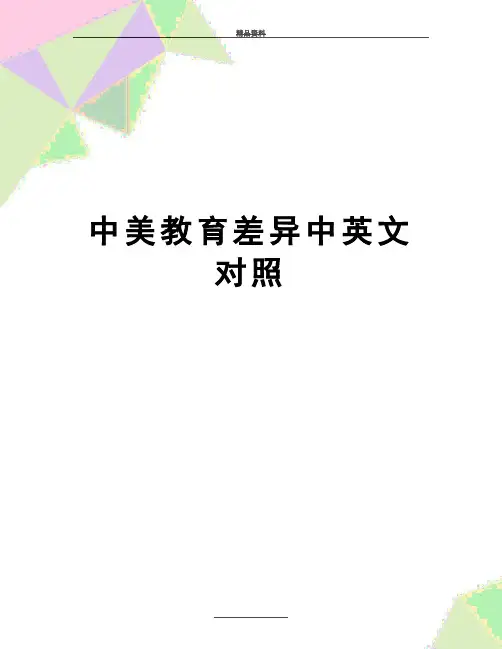
精品资料中美教育差异中英文对照........................................China and Weste rn Countries’ social backgroundRegime---socialist system (China)capitalist system (Western Countries)Historic Culture ---China traditional culture (Confucianism)Western traditionalculture (Revival of Literature and Art, Advanced ideas) Family institution's position---in china's traditional family, parents' authoritativeconsciousness plays a leading roleWestern civilization mainly emphasizes struggle, equality, democracy and human rights.中国和西方国家的社会背景:政权——-socialist系统(中国)资本主义制度(西方国家)历史文化————中国传统文化(儒家)西方传统文化(文学和艺术的复兴,先进理念)家庭机构的立场——中国传统的家庭,父母的权威意识起着主导作用西方文明主要强调斗争,平等、民主和人权。
Social Environmental InfluenceWhat Chinese lack most is the responsibility education. In the United States, it is common to see an adult who is doing something wrong or has some bad behaviors educates a child while the child is not the adult’s own kid. The Americans treat every child as their own child, and it is their responsibility to educate the child. In England, the power of a middle-aged woman is inevitable. They are always in the supervision of the behavior of young consciously, just as the police general. They think it is their duty to observe the children in their country. These two nations have already put the responsibility of educating the next generation to every citizen. Every citizen also shows his responsibility for he future of the country in caring about the children.While in China, who will treat educating the next generation as his own responsibility? If one sees an unknown child who is doing something wrong, will he go and educate him? It is very common in China that adults tend to show indifferent with unknownchildren. What if we change our mind and learn to care others?社会环境影响中国最缺乏的是责任教育。

外国教育与中国教育的区别英语作文全文共3篇示例,供读者参考篇1Differences between Foreign Education and Chinese EducationAs education plays an important role in shaping individuals and societies, it is interesting to compare the education systems of different countries. In this article, we will discuss the differences between foreign education and Chinese education.One of the key differences between foreign education and Chinese education is the teaching methods. In many Western countries, there is an emphasis on student-centered learning, where students are encouraged to think critically, express their own opinions, and actively engage in the learning process. This approach allows students to develop problem-solving skills, creativity, and independence. In contrast, Chinese education often follows a more traditional teacher-centered approach, where teachers hold authority and students are expected to listen passively and memorize information. This can sometimeslead to a lack of critical thinking skills and creativity among Chinese students.Another difference is the curriculum. Foreign education systems are often more flexible, allowing students to choose their own courses and pursue their interests. For example, in the United States, students can select elective courses in fields such as art, music, or computer science, in addition to the core subjects. On the other hand, the Chinese education system is quite rigid, with a focus on standardized testing and a set curriculum for all students. This can limit students' opportunities to explore different subjects and discover their passions.Furthermore, foreign education tends to place a greater emphasis on holistic development. Many schools in Western countries prioritize the development of students' social and emotional skills, as well as their academic abilities. For instance, schools in Finland have a strong focus on student well-being and small class sizes to support individualized learning. In contrast, Chinese education tends to prioritize academic achievement above all else, with a heavy emphasis on exam results and rankings. This can lead to high levels of stress and pressure among Chinese students.In terms of assessment, there are also differences between foreign education and Chinese education. In many Western countries, students are assessed through a variety of methods, including essays, projects, presentations, and exams. This allows for a more comprehensive evaluation of students' abilities and encourages them to demonstrate their knowledge in different ways. In China, however, the education system is heavily reliant on standardized testing, such as the Gaokao, which determines students' future academic and career opportunities. This can create a competitive and high-stakes environment for students, with a strong focus on rote memorization and test preparation.In conclusion, while both foreign education and Chinese education have their strengths and weaknesses, there are clear differences in terms of teaching methods, curriculum, holistic development, and assessment. The key is for educators to learn from each other and adapt best practices to create a more effective and balanced education system that can benefit students worldwide.篇2Education plays a crucial role in shaping an individual's mindset, skills, and future opportunities. Different countries have developed their own unique educational systems, each with itsstrengths and weaknesses. In this essay, we will explore the differences between foreign education and Chinese education.Firstly, foreign education systems tend to focus more on critical thinking and creativity. Students are encouraged to question, analyze, and think independently. In contrast, Chinese education places a heavy emphasis on rote memorization and exams. Students are often required to memorize vast amounts of information without fully understanding the concepts behind them. This can stifle creativity and critical thinking skills.Secondly, foreign education systems are morestudent-centered. They prioritize the individual needs and interests of each student, allowing them to pursue their passions and talents. In Chinese education, the focus is more on conformity and uniformity. Students are expected to follow a rigid curriculum and conform to societal expectations. This can lead to a lack of individuality and personal growth.Furthermore, foreign education systems place a greater emphasis on practical skills and real-world application. Students are often given hands-on experience and opportunities to develop practical skills that are relevant to their future careers. Chinese education, on the other hand, tends to focus more on theoretical knowledge and academic performance. This cansometimes lead to a disconnect between what is taught in schools and what is required in the workplace.Another key difference is the role of teachers in the education system. In foreign countries, teachers are seen as facilitators and mentors who guide students in their learning journey. They encourage critical thinking, creativity, and independent thinking. In China, teachers are often viewed as authority figures who impart knowledge to students. This hierarchical relationship can sometimes hinder communication and collaboration between teachers and students.In conclusion, the differences between foreign education and Chinese education are significant. While both systems have their strengths and weaknesses, it is important for policymakers and educators to learn from each other and strive for continuous improvement. By understanding and embracing the best practices of both systems, we can create a more holistic and effective educational system that prepares students for the challenges of the future. Education is the key to unlocking the potential of individuals and societies, and it is essential that we continue to innovate and evolve in order to provide the best possible learning experience for all.篇3Differences Between Foreign Education and Chinese EducationEducation is an essential part of every society, shaping the minds of the younger generation and preparing them for the future. While education systems around the world share similar goals of cultivating knowledge, critical thinking, and skills for students, there are distinct differences between foreign education and Chinese education. In this essay, we will explore these differences and understand how they impact the quality of education in each system.One of the primary differences between foreign education and Chinese education lies in the teaching methods and curriculum. In many foreign countries, students are encouraged to think independently, question authority, and participate in interactive and hands-on learning experiences. Teachers play the role of facilitators rather than dictators, guiding students through discussions, debates, and projects that encourage creativity and critical thinking.On the other hand, Chinese education traditionally emphasizes rote memorization, obedience, and conformity in the classroom. Students are expected to listen to the teacher, take notes, and pass exams based on memorized information.The curriculum is often focused on technical subjects such as math and science, with less emphasis on arts, humanities, and social sciences.Another significant difference between foreign education and Chinese education is the assessment and evaluation of students. In many foreign countries, students are assessed through a combination of exams, projects, presentations, and class participation. This holistic approach to evaluation allows students to demonstrate their knowledge, skills, and creativity in different ways, providing a more comprehensive measure of their understanding and abilities.In contrast, Chinese education relies heavily on standardized tests to evaluate students' academic performance. The Gaokao, China's national college entrance examination, is a high-stakes test that determines students' future academic and career prospects. The emphasis on test scores puts immense pressure on students to perform well, often leading to stress, anxiety, and mental health issues.Another key difference between foreign education and Chinese education is the learning environment and school culture. In many foreign countries, schools prioritize student well-being, mental health, and personal growth. Schools providesupport services, counseling, extracurricular activities, and opportunities for students to pursue their interests and passions outside of the classroom.In contrast, Chinese schools focus primarily on academic achievement and discipline, with little emphasis on students' emotional and psychological development. The competitive nature of the education system encourages students to prioritize studying and grades over their own well-being, leading to burnout, depression, and a lack of social skills.Moreover, foreign education tends to be more inclusive and diverse, welcoming students from different cultural, religious, and socio-economic backgrounds. Schools in foreign countries promote tolerance, acceptance, and diversity, allowing students to learn from each other's perspectives and experiences. This multicultural environment fosters global citizenship, intercultural communication, and mutual understanding among students.In contrast, Chinese education tends to be more homogenous and uniform, with a focus on conformity, unity, and national identity. The education system in China emphasizes Chinese language, history, and culture, promoting patriotism, loyalty, and respect for authority. While this approach fosters asense of national pride and unity, it may limit students' exposure to different cultures, traditions, and ways of thinking.In conclusion, the differences between foreign education and Chinese education reflect the unique values, priorities, and challenges of each system. While foreign education emphasizes creativity, critical thinking, and diversity, Chinese education prioritizes discipline, conformity, and academic achievement. By understanding these differences, we can appreciate the strengths and weaknesses of each system and work towards creating a more balanced and holistic approach to education that benefits all students.。
中西教育对比英文作文英文:When it comes to comparing Chinese and Western education, there are certainly some key differences to consider. In my experience, Western education tends to place a greater emphasis on critical thinking and creativity, while Chinese education is often more focused on rote memorization and test-taking.One major difference is the way that students are encouraged to think and learn. In Western education, there is often a greater emphasis on independent thinking and exploration. Students are encouraged to ask questions and challenge assumptions, and to develop their own ideas and opinions. This can be seen in the way that Western classrooms are often structured, with students working in small groups or pairs to discuss and debate ideas.In contrast, Chinese education tends to be morestructured and focused on following rules and procedures. Students are expected to memorize a lot of information and perform well on exams, rather than developing their own ideas or opinions. This can be seen in the way that Chinese classrooms are often more teacher-centered, with the teacher lecturing and students taking notes.Another key difference is the way that creativity is encouraged and valued. In Western education, creativity is often seen as a key skill to develop, and students are encouraged to think outside the box and come up with innovative solutions to problems. This can be seen in the way that Western schools often have art classes, music classes, and other creative outlets for students.In Chinese education, however, creativity is often less valued, and students are expected to conform to established norms and rules. This can be seen in the way that Chinese schools often prioritize academic subjects like math and science over art and music.Overall, there are certainly pros and cons to bothChinese and Western education systems. While Western education may encourage more independent thinking and creativity, Chinese education may be more effective at preparing students for exams and standardized tests. Ultimately, the best education system is one that takes the strengths of both approaches and combines them in a waythat best suits the needs of the students.中文:当谈到比较中西教育时,有一些关键的差异需要考虑。
美国教育和中国教育的不同的英语作文Differences Between American Education and Chinese EducationEducation plays a vital role in shaping the future generation, and different countries have adopted various education systems to cater to the needs of their societies. Among them, American education and Chinese education are two major systems that have attracted global attention for their unique characteristics and approaches. In this essay, I will explore and compare the differences between American education and Chinese education.First and foremost, one of the most significant differences between the two education systems lies in their teaching philosophies. American education emphasizes fostering creativity, critical thinking, and individuality among students. Students are encouraged to express their opinions, think independently, and explore their interests through various elective courses and extracurricular activities. In contrast, Chinese education focuses more on rote memorization, discipline, and standardized testing. Students are expected to follow a rigid curriculum, excel in exams, and adhere to strict rules and regulations.Another major difference between American education and Chinese education is the teaching methods employed in classrooms. In American schools, teachers often use interactive and collaborative teaching approaches to engage students in discussions, group projects, and hands-on activities. Students are encouraged to ask questions, challenge ideas, and participate actively in the learning process. On the other hand, Chinese schools primarily rely on lecture-based teaching, where teachers deliver information to students, who are expected to listen attentively and take notes. The emphasis is on transmitting knowledge rather than fostering student-centered learning.Furthermore, the assessment and grading systems in American education and Chinese education also differ significantly. In the United States, students are generally evaluated based on a combination of factors, including class participation, homework assignments, projects, quizzes, and exams. Grades are used as a feedback mechanism to help students track their progress and identify areas for improvement. In contrast, Chinese students are predominantly assessed through standardized tests, such as the Gaokao (national college entrance exam), which plays a decisive role in determining their future academic and career paths. High scores in exams are highly valued and can have a lasting impact on students' lives.Moreover, the school culture and extracurricular activities in American education and Chinese education exhibit distinct characteristics. American schools promote a diverse and inclusive environment that encourages students to embrace their individuality, celebrate diversity, and pursue their passions beyond academics. Students have the freedom to participate in sports, music, drama, art, debate, and other extracurricular activities to develop their talents and social skills. In contrast, Chinese schools prioritize academic achievement above all else, often leading students to spend long hours studying and attending test preparation classes after school. While some Chinese schools offer limited extracurricular opportunities, the focus remains on academic excellence.In conclusion, American education and Chinese education have distinct approaches to teaching, learning, assessment, and school culture. While American education emphasizes creativity, critical thinking, and student-centered learning, Chinese education prioritizes rote memorization, standardized testing, and academic achievement. Both systems have their strengths and weaknesses, and understanding the differences between them can provide valuable insights for improving education worldwide. Ultimately, the goal of education is to empower students to realize their full potential, contribute to society, andlead fulfilling lives. By embracing the uniqueness of each education system and learning from their best practices, we can create a more inclusive, innovative, and effective educational experience for all students.。
中美教育差异英语作文英文回答:In terms of education, there are some notabledifferences between China and the United States. One major difference is the emphasis on standardized testing in China. In China, students are required to take the Gaokao, a high-stakes exam that determines their future educational and career opportunities. This puts a lot of pressure on students to perform well on this exam, and as a result,they spend a significant amount of time preparing for it.On the other hand, in the United States, there is less emphasis on standardized testing and more focus on holistic education. Students are encouraged to participate in extracurricular activities, pursue their passions, and develop critical thinking skills. This allows for a morewell-rounded education and gives students the opportunityto explore their interests and talents.Another difference is the teaching style. In China, the teaching style is often more traditional, with a focus on rote memorization and teacher-centered instruction. Students are expected to listen to the teacher and absorb information without much room for discussion or debate.In the United States, the teaching style is more interactive and student-centered. Teachers often encourage class discussions, group projects, and critical thinking. This fosters a more dynamic and engaging learning environment where students are encouraged to express their opinions and think critically about the material.Furthermore, the school schedule and structure are different in the two countries. In China, the school day is typically longer, and students often have large amounts of homework and study time outside of school. In the United States, the school day is shorter, and there is less emphasis on homework, allowing students more time for extracurricular activities and personal interests.Overall, these differences in education reflect thecultural and societal values of each country. While the Chinese education system emphasizes academic achievement and discipline, the American education system values creativity, critical thinking, and personal development.中文回答:在教育方面,中国和美国存在一些明显的差异。
中西教育差异:探索中国与美国教育方式的对比In the vast landscape of global education, China and the United States occupy two distinct and intriguing peaks. Each nation's educational system is shaped by its unique history, culture, and societal values, resulting in significant differences that impact students' learning experiences and outcomes. This essay aims to delve into these differences, highlighting the varying approaches and outcomes of education in China and the United States.**Curriculum Design and Content**In China, the curriculum tends to be more standardized and focused on core subjects such as math, science, and language arts. This approach ensures that students across the country receive a consistent and comprehensive education, emphasizing depth and mastery of fundamental concepts. By contrast, the American education system offers a more diverse and flexible curriculum, allowing students to explore a wider range of subjects and pursue their interests. This approach cultivates creativity and encourages students to think outside the box.**Teaching Methods and Classroom Dynamics**Chinese classrooms often emphasize discipline and rote learning, with teachers playing a more authoritative role. This approach fosters a culture of respect and obedience, but it can also limit students' autonomy and creativity. In contrast, American classrooms tend to be more informal and interactive, with teachers serving as facilitators rather than authorities. This approach encourages active participation and critical thinking, fostering a more dynamic and innovative learning environment.**Assessment and Evaluation**Assessment in Chinese education is typically based on exams and homework, with a strong emphasis on grades and academic achievement. This system rewards consistency and mastery of content but can sometimes lead to excessive stress and a narrow focus on grades rather than learning. By contrast, American education evaluates students more comprehensively, considering a range of factors such as participation, creativity, and critical thinking. This approach recognizes the value of diverse skills andperspectives, but it can also be more subjective and less consistent.**The Role of Parents and Society**In China, parents and society place a high value on education, often expecting students to excel academically. This pressure can drive students to achieve, but it can also lead to feelings of anxiety and inadequacy. In the United States, while education is still highly valued, there is a greater emphasis on personal growth and development. Parents and society tend to be more supportive and encouraging, fostering a more positive and inclusive learning environment.**Conclusion**The differences between Chinese and American education systems are numerous and complex, reflecting the distinct cultural and societal values of each nation. While there are advantages and disadvantages to both approaches, it is important to recognize that education is not a one-size-fits-all process. Instead, it should be tailored to the needs and aspirations of individual students, allowing themto reach their full potential regardless of their background or location.**中西教育差异:探索中国与美国教育方式的对比** 在全球教育的广阔天地中,中国和美国各自占据着独特且引人注目的高峰。